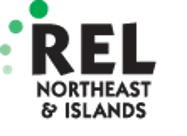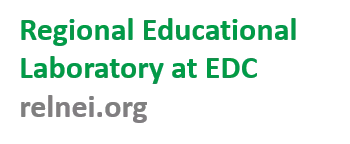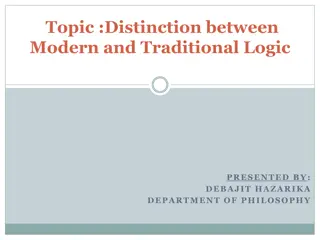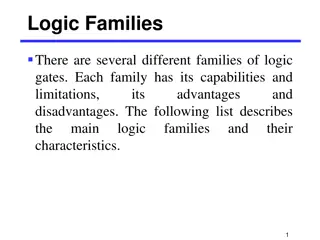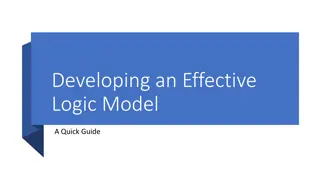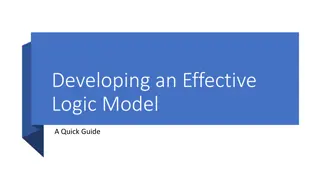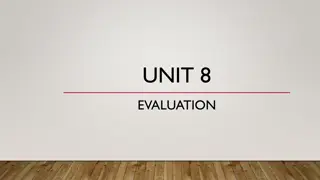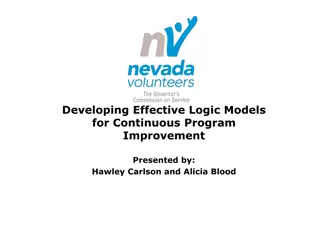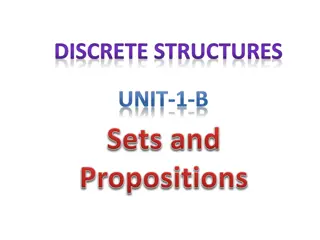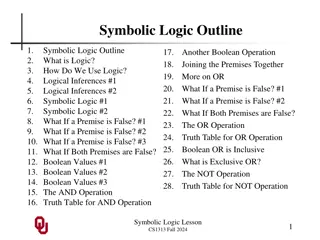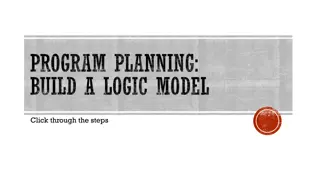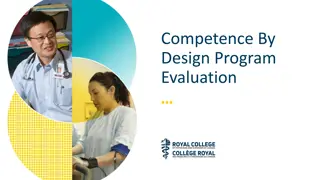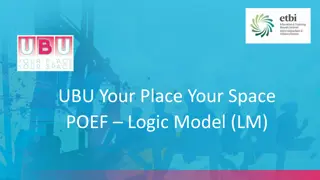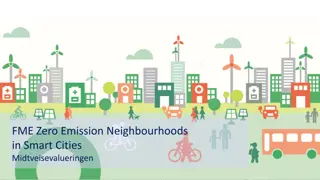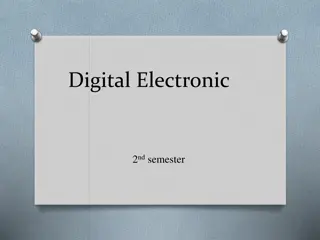Logic Models for Program Design and Evaluation
Explore the concept of logic models as a valuable tool in program design, implementation, and evaluation. Learn about the elements of a logic model, its importance in clarifying program goals and outcomes, and how to construct one effectively for various initiatives. Dive into case examples and practical application to enhance your understanding of logic models in action.
Download Presentation

Please find below an Image/Link to download the presentation.
The content on the website is provided AS IS for your information and personal use only. It may not be sold, licensed, or shared on other websites without obtaining consent from the author.If you encounter any issues during the download, it is possible that the publisher has removed the file from their server.
You are allowed to download the files provided on this website for personal or commercial use, subject to the condition that they are used lawfully. All files are the property of their respective owners.
The content on the website is provided AS IS for your information and personal use only. It may not be sold, licensed, or shared on other websites without obtaining consent from the author.
E N D
Presentation Transcript
Logic Models to Support Program Design, Implementation, and Evaluation Session I: Learning about Logic Models Hosted by the [insert alliance here] Moderator: Presenter: Date Time Regional Educational Laboratory at EDC relnei.org 1
Introductions Workshop facilitator: Participants: Name and affiliation Regional Educational Laboratory at EDC relnei.org 2
Agenda Introduction and goals Introducing the cases What is a logic model? Elements of a logic model The logic in a logic model Next steps Regional Educational Laboratory at EDC relnei.org 3
Session I Goals Introduce logic models as an effective tool for program and policy design, implementation, and evaluation Practice the elements of a logic model Provide guidance on the appropriate steps for building a logic model for a program or initiative Regional Educational Laboratory at EDC relnei.org 4
Case Examples College-Ready and Blended Learning Programs Activity I.1: Discussion of Cases Consider one of the cases: What are the goals of the program or policy? What might we want to know about it? Regional Educational Laboratory at EDC relnei.org 5
What Is a Logic Model? Where are you going? How will you get there? What will tell you that you have arrived? Regional Educational Laboratory at EDC relnei.org 6
What Is a Logic Model? A logic model: Provides a simplified picture of the relationships between the program inputs and the desired outcomes of the program Is a framework for: o Planning o Implementation o Monitoring o Evaluation Is a graphic and explicit representation of relationships, assumptions, and rationale Regional Educational Laboratory at EDC relnei.org 7
What Is a Logic Model? A logic model is not: A strategic plan or a fully developed plan for designing or managing a program or policy An evaluation design or an evaluation method Regional Educational Laboratory at EDC relnei.org 8
What Is a Logic Model? Types of logic models: Theory approach model: Conceptual, emphasizes theory of change (program design) Activities approach model: Activities and relationships, detailed steps (program management and implementation) Outcomes approach model: Connects resources and activities with results and outcomes, may break up outcomes and impacts over time segments (program evaluation) Regional Educational Laboratory at EDC relnei.org 9
What Is a Logic Model? The simplest form of a logic model: INPUTS OUTPUTS OUTCOMES Regional Educational Laboratory at EDC relnei.org 10
What Is a Logic Model? The simplest form of a logic model: INPUTS OUTPUTS OUTCOMES Inputs: What is invested in the program (e.g., money, people, time, and space) Outputs: What is done in the program (e.g., program strategies and activities) Outcomes: What results from the program (i.e., short- and long-term outcomes) Regional Educational Laboratory at EDC relnei.org 11
What Is a Logic Model? Case: Blended-Learning Program Inputs Outputs Outcomes Existing technology infrastructure Infrastructure audit completed Teachers reported use of diverse instruction strategies increases. Technology integration staff person for three schools Six days of summer teacherprofessional development completed Student engagement increases. Student achievement on districtwide assessments improves. Teachers enthusiasm in three schools Six blended-learning classrooms established Technology integration grant Regional Educational Laboratory at EDC relnei.org 12
What Is a Logic Model? Activity I.2: Inputs Outputs Outcomes Inputs Outputs Outcomes Regional Educational Laboratory at EDC relnei.org 13
What Is a Logic Model? Case: College-Ready Program Inputs Outputs Outcomes Staff Course for parents Parent involvement increases. Volunteer mentors Mentoring for students College applications increase. School space and resources Guidance meetings Student meetings College acceptances increase. Teacher time College attendance increases. Regional Educational Laboratory at EDC relnei.org 14
Elements of a Logic Model Problem Statement Strategies and Activities Outputs Short-Term Outcomes Impacts Resources (inputs) Long-Term Outcomes Assumptions Regional Educational Laboratory at EDC relnei.org 15
Elements of a Logic Model The elements of a logic model: Problem statement Short- and long-term outcomes Impacts Outputs Strategies and activities Resources (inputs) Assumptions Regional Educational Laboratory at EDC relnei.org 16
Elements of a Logic Model: Problem Statement Problem statement: The problem or challenge that the program or policy is designed to address Questions to ask in defining the problem: What is the problem or issue? Why is this a problem? For whom does this problem exist? Who has a stake in the problem? What is known about the problem (through previous work, research, etc.)? Regional Educational Laboratory at EDC relnei.org 17
Elements of a Logic Model: Problem Statement Problem statement: The problem or challenge that the program or policy is designed to address Case: Blended-Learning Program Students are not actively engaged in their learning. Courses are sometimes monotonous. Students have limited one-on-one attention from adults. Students courses are not personalized. Students are all expected to work at the same pace. Regional Educational Laboratory at EDC relnei.org 18
Elements of a Logic Model: Problem Statement Problem statement: The problem or challenge that the program or policy is designed to address Activity I.3: Problem Statement Articulate a targeted and specific problem Avoid a problem statement that restates the program as a need Regional Educational Laboratory at EDC relnei.org 19
Elements of a Logic Model: Outcomes Outcomes: What difference does it make? Regional Educational Laboratory at EDC relnei.org 20
Elements of a Logic Model: Outcomes Outcomes: What difference does it make? Short-term Long-term Impacts Regional Educational Laboratory at EDC relnei.org 21
Elements of a Logic Model: Outcomes Outcomes: What difference does it make? Short-term Most immediate and measurable results for participants that can be attributed to strategies and activities Long-term Impacts Regional Educational Laboratory at EDC relnei.org 22
Elements of a Logic Model: Outcomes Outcomes: What difference does it make? Short-term Most immediate and measurable results for participants that can be attributed to strategies and activities Long-term Impacts More distant, though anticipated, results of participation in strategies and activities Regional Educational Laboratory at EDC relnei.org 23
Elements of a Logic Model: Outcomes Outcomes: What difference does it make? Short-term Most immediate and measurable results for participants that can be attributed to strategies and activities Long-term Impacts More distant, though anticipated, results of participation in strategies and activities Desired outcomes of long-term implementation of strategies and activities, dependent on conditions beyond the scope of the program Regional Educational Laboratory at EDC relnei.org 24
Elements of a Logic Model: Outcomes Outcomes: What difference does it make? Case: College-Ready Program Short-term Increased contact with parents or guardians Long-term Impacts Improved attendance and academic performance Increased percentage of students graduating from postsecondary institutions Regional Educational Laboratory at EDC relnei.org 25
Elements of a Logic Model: Outcomes Outcomes: What difference does it make? Activity I.4: Focus on Outcomes What is the desired change? (action verb) Increase Who is the target? High school seniors in three urban comprehensive high schools In what? (results) Applications to postsecondary institutions By when? By June 2014 Regional Educational Laboratory at EDC relnei.org 26
Elements of a Logic Model: Outcomes Outcomes Checklist Important Reasonable Realistic Unintentional, possibly negative Regional Educational Laboratory at EDC relnei.org 27
Elements of a Logic Model: Strategies and Activities Strategies and activities: What you propose to do to address the problem Activities, services, events, and products: Are designed to address the problem Are, together, intended to lead to certain outcomes Regional Educational Laboratory at EDC relnei.org 28
Elements of a Logic Model: Strategies and Activities Strategies and activities: What you propose to do to address the problem Example: Blended-Learning Program Activities Develop teacher training materials 1st Sequence Strategy Professional training Professional training Infrastructure Deliver summer institute 2nd Conduct technology audit 1st And so forth Regional Educational Laboratory at EDC relnei.org 29
Elements of a Logic Model: Strategies and Activities Any questions so far? Regional Educational Laboratory at EDC relnei.org 30
Elements of a Logic Model: Resources Resources (inputs): The material and intangible contributions that are or could reasonably be expected to be available to address the problem Examples: Money, materials, and equipment (material/tangible) People, time, and partnerships (intangible) Resources are the inputs that enable the creation of the strategies and activities that are designed to respond to the stated problem. Regional Educational Laboratory at EDC relnei.org 31
Elements of a Logic Model: Resources Resources (inputs): The material and intangible contributions that are or could reasonably be expected to be available to address the problem Case: College-Ready Program Community mentors Local university space for parent meetings Volunteer college admissions directors for application workshop Student volunteers for childcare at parent meetings Regional Educational Laboratory at EDC relnei.org 32
Elements of a Logic Model: Resources Intangible resources: What intangible resources are at your disposal? Activity I.5: Intangible Resources Brainstorm at least five nonmonetary resources that are available to you in a program you operate or manage. Regional Educational Laboratory at EDC relnei.org 33
Elements of a Logic model: Assumptions Assumptions: Beliefs about participants, staff, the program, and how change or improvement may be realized Make explicit all implicit assumptions: Assumptions can be internal and external. Ask: What is known, and what is being assumed? Regional Educational Laboratory at EDC relnei.org 34
Elements of a Logic model: Assumptions Assumptions: Beliefs about participants, staff, the program, and how change or improvement may be realized Case: Blended-Learning Program Internal Assumptions The participating school leadership will continue to support the program. Three staff members will be sufficient to support the program in three schools. External Assumptions Access to a range of modalities will increase student engagement. Increased student engagement will increase academic achievement. Regional Educational Laboratory at EDC relnei.org 35
Elements of a Logic model: Assumptions Assumptions: Beliefs about participants, staff, the program, and how change or improvement may be realized Activity I.6: Uncovering Internal and External Assumptions What assumptions are you or your program making? Regional Educational Laboratory at EDC relnei.org 36
The Logic in a Logic Model The theory embedded in the model A series of if-then statements across the model Regional Educational Laboratory at EDC relnei.org 37
The Logic in a Logic Model The theory embedded in the model A series of if-then statements across the model Case: Blended-Learning Program If: Then: and If: Then: Instruction will be personalized and participating students will be more engaged Student achievement will increase as measured by standardized assessment District invests in blended learning in three schools Regional Educational Laboratory at EDC relnei.org 38
The Logic in a Logic Model Activity I.7: If-Then Statements Order the if-then statements in the example from the College-Ready Program case Regional Educational Laboratory at EDC relnei.org 39
Next Steps What we have accomplished so far? Discussed the purpose of a logic model Presented the elements of a logic model Considered the logic embedded in a logic model Regional Educational Laboratory at EDC relnei.org 40
Next Steps Ask yourself the following: Do I understand the elements of the logic model and how they differ? Who should I consult in developing the model? What colleagues and stakeholders should be participants in developing the logic model? Who will shepherd or see through the development of the logic model? How do I know we have captured the theory of action? How will we use the logic model? How will we ensure we make it a living document? Regional Educational Laboratory at EDC relnei.org 41
Next Steps Your next steps Activity I.8: What Are Your Next Steps with Regard to Logic Models? Regional Educational Laboratory at EDC relnei.org 42
Final Thoughts on Logic Models Some final thoughts Logic models are tools for program design, implementation, and evaluation. The process of developing a logic model is important: Engage stakeholders in developing a logic model. Logic models should be living documents and returned to frequently. Logic models are useful for evaluation but best when developed at the program design phase. Regional Educational Laboratory at EDC relnei.org 43
Thank You! For any questions about this workshop, contact: Regional Educational Laboratory at EDC relnei.org 44
Logic Models to Support Program Design, Implementation, and Evaluation Session II: From Logic Models to Program and Policy Evaluation Hosted by the [insert alliance here] Moderator: Presenter: Date Time Regional Educational Laboratory at EDC relnei.org 45
Introductions Workshop facilitator: Participants: Name and affiliation Regional Educational Laboratory at EDC relnei.org 46
Agenda Introduction and goals Review of logic models Introducing evaluations Moving from logic models to evaluation questions Generating indicators Building an evaluation design Putting it all together Regional Educational Laboratory at EDC relnei.org 47
Session II Goals Reintroduce logic models as an effective tool, specifically for evaluation. Practice using logic models to develop evaluation questions and indicators of success. Provide guidance on how to determine the appropriate evaluation for a specific program or policy. Regional Educational Laboratory at EDC relnei.org 48
Review of Logic Models A logic model is: A graphic representation of theory of change A framework for planning, implementation, monitoring, and evaluation A logic models is not: A strategic plan or a fully developed plan for designing or managing a program or policy An evaluation design or evaluation method Regional Educational Laboratory at EDC relnei.org 49
Review of Logic Models Problem Statement Strategies and Activities Outputs Short-Term Outcomes Impacts Resources (inputs) Long-Term Outcomes Assumptions Regional Educational Laboratory at EDC relnei.org 50





